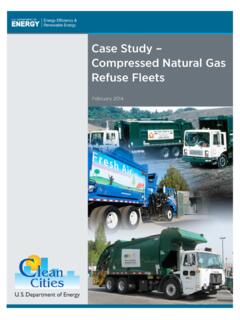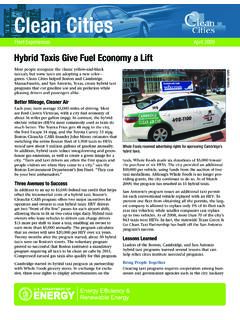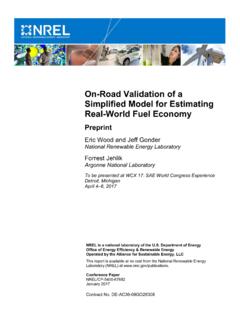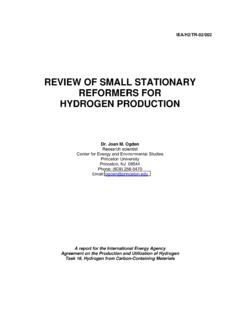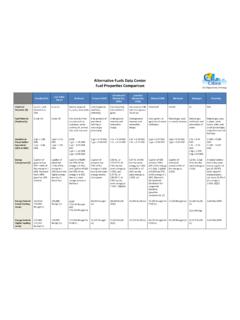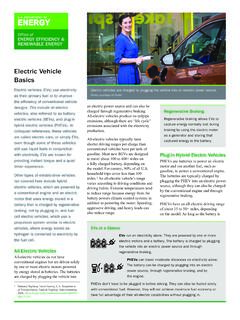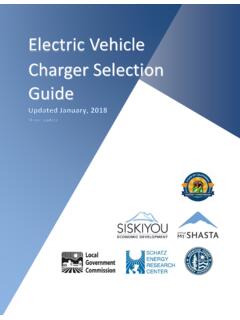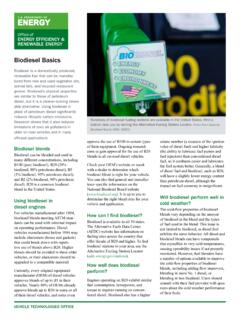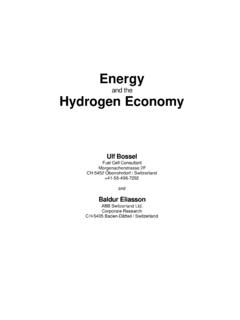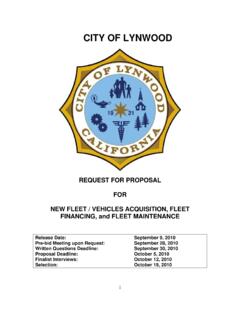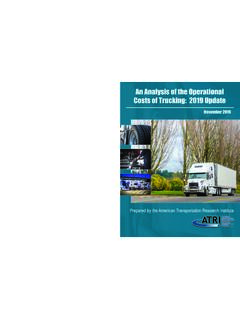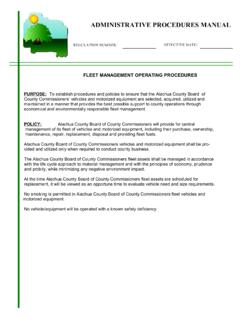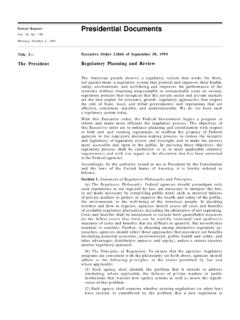Transcription of Costs Associated With Non-Residential Electric Vehicle ...
1 Costs Associated With Non-Residential Electric Vehicle Supply EquipmentFactors to consider in the implementation of Electric Vehicle charging stationsNovember 2015 Prepared by New West Technologies, LLC for the Department of Energy Vehicle Technologies Office2 Acknowledgments Acknowledgments This report was produced with funding from The Department of Energy s (DOE) Clean Cities program. DOE s Clean Cities Co-director Linda Bluestein and Workplace Charging Challenge Coordinator Sarah Olexsak provided direction and overall guidance for this pursuit.
2 This report was made possible by input from national laboratories, utilities, electricians, Electric Vehicle supply equipment manufacturers, and charging station hosts. The authors are grateful for all the information provided by subject matter experts and would like to extend a special thank you to Jim Francfort, Idaho National Laboratory; Ted Bohn and Dan Santini, Argonne National Laboratory; Charlie Botsford, AeroVironment; and Randy Schimka, San Diego Gas and Electric . The wide variety of the reviews greatly added to the robustness and accuracy of this report, but any errors herein are solely the authors Smith, New West Technologies LLCJ onathan Castellano, New West Technologies LLCE xecutive Summary 3 Executive Summary As more drivers purchase plug-in Electric vehicles (PEVs), there is a growing need for a network of Electric Vehicle supply equipment (EVSE) to provide power to those vehicles.
3 PEV drivers will primarily charge their vehicles using residential EVSE, but there is also a need for Non-Residential EVSE in workplace, public, and fleet settings. This report provides information about the Costs Associated with purchasing, installing, and owning Non-Residential EVSE. cost information is compiled from various studies around the country, as well as input from EVSE owners, manufacturers, installers, and utilities. The cost of a single port EVSE unit ranges from $300-$1,500 for Level 1, $400-$6,500 for Level 2, and $10,000-$40,000 for DC fast charging.
4 Installation Costs vary greatly from site to site with a ballpark cost range of $0-$3,000 for Level 1, $600-$12,700 for Level 2, and $4,000-$51,000 for DC fast factors lead to highly variable Costs Associated with EVSE. The report includes example cost ranges for both different types and applications of EVSE as well as the cost factors that can influence whether a particular EVSE unit or installation will fall on the lower or higher end of the cost range. Employers, business owners, and fleet operators can find the best EVSE solution for a specific site by evaluating needs and opportunities, then strategically determining the optimal number of EVSE, types of features, and location.
5 In general, there is an industry consensus that the cost of EVSE units is trending downwards and will continue to decrease. However, installation Costs are highly variable and there is no consensus among industry stakeholders about the direction of future installation Costs . In addition, state and local incentives in many places encourage EVSE installation through funding and technical the available cost information from past EVSE installations provides a wide ballpark range for future installations, the only way to determine a cost estimate for a specific site is to contact the utility, EVSE manufacturers, and EVSE installers for a site assessment.
6 Clean Cities coalitions around the country bring together a network of contacts in the Electric Vehicle industry and are a good starting place for identifying local contacts. To find a local Clean Cities coalition, visit 4 Table of ContentsTable of ContentsIntroduction ..6 EVSE Overview ..6 EVSE Costs Overview ..7 EVSE Unit Costs ..9 EVSE Unit cost Drivers ..9 EVSE Unit Costs Ranges and Costs ..13 Installation cost Drivers ..13 Installation cost Ranges and Examples ..17 Operation and Maintenance (O&M) Costs ..20 Electricity Consumption Charges.
7 20 Electricity Demand Charges ..20 Network Fees ..21 Maintenance and Repair ..21 Station Management ..22 Additional cost Factors ..22 Incentives ..22 Permitting and Inspection ..24 Workplace, Public, and fleet EVSE Costs ..24 cost Factors to Consider for Workplace Charging ..25 cost Factors to Consider For Public Factors to Consider for fleet Charging ..28 Summary ..29 Tips for Minimizing EVSE Costs ..29 Additional Resources ..32 Appendix A: Acronyms, Definitions, and Equipment Overview ..33 Appendix B: Codes and Standards ..37 Appendix C: Electricity Consumption Examples.
8 38 Appendix D: State and Utility EVSE Incentives ..39 Appendix E: References ..42 List of Figures 5 List of FiguresFigure 1 PEV Charging Pyramid..6 Figure 2 AC Level 1 and Level 2 Charging Schematic ..6 Figure 3 DC Fast Charging Schematic ..6 Figure 4 Charging Level Descriptions ..7 Figure 5 Ballpark cost Ranges for Level 2 EVSE ..12 Figure 6 Average Installation cost for Publicly Accessible Level 2 7 Distribution of Per Unit Publicly Accessible Installation Costs ..18 Figure 8 Distribution of Per Unit Workplace Level 2 Installation Costs .
9 19 Figure 9 Distribution of DCFC Installation Costs ..19 Figure 10 State EVSE Incentives Map ..23 Figure 11 Level 2 Average Installation cost by Setting ..25 List of TablesTable 1 EVSE Unit Costs ..11 Table 2 Ballpark EVSE Installation Costs ..17 Table 3 Example EVSE Incentives ..23 Table 4 Ballpark EVSE Unit and Installation Costs ..30 Table 5 Connector Standards, Charging Levels, and Vehicles ..366 Introduction Introduction This document is designed to help employers, business owners, and fleet operators understand the Costs Associated with installing, operating, and maintaining Electric Vehicle supply equipment (EVSE), also known as Electric Vehicle charging stations.
10 It provides an overview of the equipment and processes needed to install EVSE and offers representative examples of cost ranges. The information presented is based on data collected from various studies around the country, as well as input from EVSE owners, manufacturers, installers, and utilities. Many plug-in Electric Vehicle (PEV) drivers charge their vehicles at home using residential charging located at single family homes or multi-family complexes such as apartments and condominiums. This report however, focuses on the Costs of Non-Residential stations such as public access, workplace, and fleet stations shown in the middle and top of the pyramid in Figure 11.
